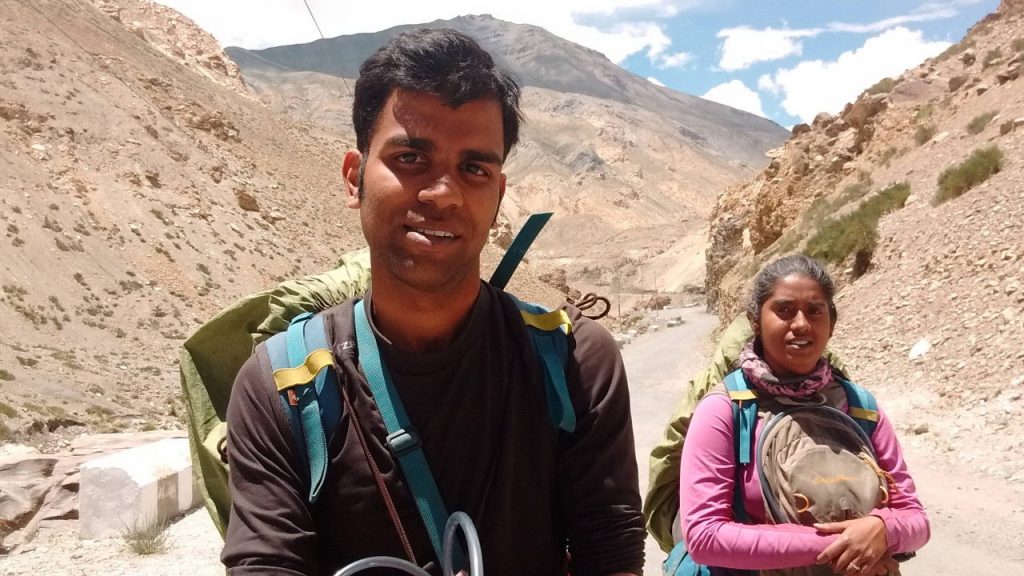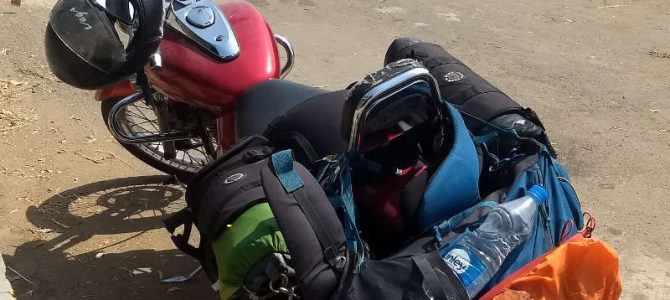The ease with which one can travel from place to place during a long journey is easily determined by how much you carry and how compactly you pack. It can mean the difference between choosing a destination because you are nimble or rejecting it because you are packed too heavy or too large. This is especially true for self-planned and backpacking trips. To be nimble and ready to go, you should pack smart and eliminate ruthlessly. You must have enough to cover your day-to-day travel life for several months, but less enough so that you are left with just not more than 60 litres and 15 kg of luggage per person. Here are some tips on frugal packing that we tested all over with India 360.
Just one set of multi-purpose clothes everyday
Unless you are visiting a place where fashionable clothes are the norm (e.g. Goa), you can get by with just one set of clothes for the entire trip. We wore the same set of dry-fit clothes everyday. Here is what worked for us:
- 1 dry-fit tee
- 1 dry-fit trouser
- 1 padded jacket for cold weather, preferably with its own hood
- 1 raincoat / poncho. If your padded jacket is waterproof, then the rainwear can be ignored.
- 1 pair of rugged shoes suitable for trekking and with ankle support
- 1 pair of socks to go with the shoes
- 1 pair of floaters/slippers to walk on city streets, hotel/lodge corridors & train corridors
- The only thing that you need in multiples is your underwear. We suggest at least 4 changes of undies.

Out of the 320 days on the road, more than 200 were spent in the above outfit.
At most one backup set of clothing
Often, we were caught in the rain while riding our motorbike in the north-east. We also got caught out by rain at places in Uttarakhand and Himachal while walking around, with hardly any tree cover and no roofs nearby. So having one set of dry cotton clothes to wear to bed for the night works great. The dry set also allows you the option to wash your main clothes once in a while if necessary. The wet travel clothes, either by rain or by washing, should be left to dry overnight.
Here are the suggested items for backup clothing.
Men: Tee/short-sleeved shirt/cotton kurta, shorts/track pants/cotton drawstring pants/cotton trousers, pullover sweater, cotton socks. Thermals for places with temperatures below 5 degrees C.
Ladies: Tee/ladies’ top/Kurti, shorts/track pants/skirt/cotton drawstring pants/palazzo pants, pullover sweater, cotton socks. Thermals for places with temperatures below 5 degrees C.
The backup cloth set should ideally be a bit more fashionable than plain dry-fits.
When you set out on the road the next morning, you should switch to your main clothes even if they are damp. Resist the temptation to use the dry backup clothes worn overnight. The damp clothes will dry due to your body heat, the sun and the wind. The dry clothes will remain dry for the night, just in case it rains or snows again. Also, remember to pack the dry set inside waterproof material such as large polythene bags or waterproof pouches.
Daily use items
Here are some other things that are useful. But they’ll easily increase the space required, so consider them carefully.
- Travel documents: Your personal IDs with photocopies, your driving license with photocopies. Documents such as travel tickets should ideally be digital and paperless. This will reduce stuffing unnecessary paper into your bag.
- Money: Wallet with cash, credit cards (2 per person), ATM cards (2 per person)
- One blanket for each traveller. Blankets can act as more than blankets in a frugally packed trip as you will see in a paragraph below.
- Electronics: Your mobile phone, laptop (ideally a compact laptop with scaled-down specifications and small screen size only for travel purposes and seperate from your main powerful laptop at home/work), chargers, fitness watch.
- Grooming/protection: Moisturising sunscreen, shower gel, shaving razor & two backup cartridges, cloth washing powder in pouches
- Snacks: Dry fruits, nuts, energy bars, biscuits (sweet or salty), bhujia
- Paper-clips, rubber bands, tie cables: To keep things tied and together, to close half-used pouches
- Pocket note-book and pen: To write things down and to journal your trip.
- Torch & two backup batteries: In case of power cuts and for walking to and from restaurants late in the evening.
- Tissue papers and wiping cloth
Leave out items like
- Bathing soap, handwash, sanitiser: Use the shower gel instead.
- Moisturiser: Carry a moisturising sunscreen instead
- Comb: Just smooth your hair with your fingers. They will tangle & come undone on the road anyway.
What about my camera?
In a strictly frugally packed tripped, we won’t suggest a DSLR at all. It requires a seperate bag of its own, along with extra lens and protection. Evaluate if you really, really need a DSLR to cover your backpacking trip. Do so only if you want to publish your trip in a professional magazine. For posting photos on your personal blog, Facebook or Instagram, it is enough to use a good point-and-shoot with good optical zoom. Phone cameras are incapable of taking good pictures in a zoomed-in mode. Even an iPhone.
If you are travelling by your own car or motorbike, the extra step to carry a DSLR may be worth considering. But if travelling by bus or train, the anxiety of protecting a DSLR from damage is sky-high. Plus you need to remember that bag at every location where you slip the bag off your shoulders, say on a restaurant table, bus overhead rack, etc.
Absolutely evaluate if DSLR is the only thing that can do justice to your photos. There is no doubt that a DSLR shoots better than a phone or a point-and-shoot. It is a must for professional photos. But for domestic sharing, i.e. for sharing with friends, family or fans on your blog, it is perfectly fine to shoot reasonably good photos on other devices and amp them up with photo editing software such as Photoshop, GIMP, Instagram filters or Snapseed.
Ranger-roll your clothes
The most common method for packing clothes is to fold them into 1/4th or 1/8th of their original sizes. This involves progressively halving the size of the clothing item by folding it symmetrically until the item can fit into a section of our suitcase/backpack. This method is okay for business trips or wedding ceremonies, which last between 2 days to 2 weeks. Such packing is definitely not suitable for a backpacking trip that lasts several months.
For a backpacking trip, the size of your luggage determines your mobility. The balance of your backpack determines the health of your back and shoulders. So, ranger-rolling is a better way to pack your clothes. The principle of this method is to create a small pocket within your clothing item using a few folds, then rolling the item onto itself and using the pocket to secure the roll such that the item does not unfurl. The principle remains the same for all clothing items, but the method is different for each. Ranger rolling saves an incredible amount of space in your backpack and helps distribute the weight of your luggage in a way that reduces the load on your shoulders and back.
You can watch a series of videos for ranger-rolling right here.
If the video above doesn’t play, click the image below to watch the series.
Buy small sachets of supplies
One great thing about the small grocery stores in Uttarakhand and Himachal Pradesh in comparison to a city retail chain like DMart is the availability of ₹ 1 sachets of snacks or washing powder. DMart and Big Bazaar are proud to give you ‘25% extra’ or ‘buy 2 get 1 free’. It is the worst possible idea for long travel. When you are seeking to reduce the volume of your luggage, the generosity of a retail chain is unwelcome. While shopping for or during your trip, ditch the tempting discounts from the retail chains and visit the local small shops who are happy to stock small single-use pouches of snacks, shampoo, washing powder and even basic medicines.
Find alternate uses for your stuff
Your shower gel becomes your shampoo, shaving cream and handwash. Your blanket becomes your carpet or window curtain in several places. A safety pin suddenly has uses that you never imagined. We often used hair bands to secure open sachets. Such is the life of long term travel. If you find that you need certain tools, look at what you already have and improvise. The last thing you need is something you buy for one use case and then having to carry for the rest of your trip where it continues to be ignored.
Bonus tip: Pack your wires neatly
Wires aren’t heavy, nor can you leave them behind under the pretext of frugality. But wires can tangle everything and cause you endless minutes of untangled, with everything trapped inside their coils. Treat wires with the respect they demand. Ideally, your electronics go into a seperate chamber in your backpack or into a seperate packing cube/ziplock pack within your backpack’s main chamber. Before you hit the road for the day, wires should be wrapped around the electronic devices they service. USB charging cables and headphones should be wrapped around your phone itself. Ditto for your laptop and its charger and the power bank and its cables. This ensures that the wires of your electronics do not get misplaced due to carelessness.
Conclusion
Of course, there are several tips on how to pack for a long trip. They start with choosing the correct backpack. But in this post, we have shared the simplest things that you need to every day on the road. Remember, even a small difference in the weight and the balance of your bag can go a long way in helping you get more out of your wanderlust.




